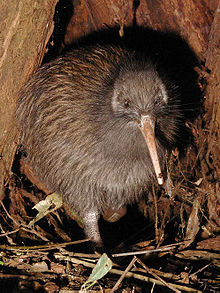North Island brown kiwi
| North Island brown kiwi | |
|---|---|
 |
|
| North Island brown kiwi, (Apteryx mantelli) | |
| Scientific classification | |
| Kingdom: | Animalia |
| Phylum: | Chordata |
| Class: | Aves |
| Order: | Apterygiformes |
| Family: | Apterygidae |
| Genus: | Apteryx |
| Species: | A. mantelli |
| Binomial name | |
|
Apteryx mantelli (Bartlett, 1851) |
|
 |
|
| The distribution of North Island brown kiwi | |
| Synonyms | |
|
|
The North Island brown kiwi (Apteryx mantelli; Apteryx australis or Apteryx bulleri as before 2000, still used in some sources), is a species of kiwi that is widespread in the northern two-thirds of the North Island of New Zealand and, with about 35,000 remaining, is the most common kiwi. This bird holds the world record for laying the largest eggs relative to its body size.
The genome of Apteryx mantelli was sequenced in 2015.
Until 2000, the brown kiwi (then Apteryx australis) was thought to include the rowi and the tokoeka, in addition to the North Island brown kiwi. However using genetic codes from each of the above it was determined that the tokoeka was a separate species, it took the Apteryx australis name, leaving the brown kiwi with its current Apteryx mantelli name. Soon after, in 1998, more genetic tests were done with the rowi and it was determined that it (the rowi) was a separate species (Apteryx rowi). In 2004 an injured bird was found with streaked white around the head and identified by Massey University. The white feathering is likely due to a rarely seen genetic variation sometimes described as a partial albino. Few documented cases exist with only a painting of one found in Otorohanga in the 18th century and a specimen in the Canterbury Museum. The injured bird recovered and was introduced into a breeding programme.
The brown kiwi was first described as Apteryx australis by Abraham Dee Bartlett, in 1813, based on a specimen from Dusky Sound, South Island, New Zealand. This is a monotypic species.
Brown kiwi are found throughout the North Island, occurring near Northland, Coromandel, Eastern North Island, Aroha Island, Little Barrier Island, Kawau Island, Ponui Island, and the Whanganui Region. The North Island brown kiwi has demonstrated a remarkable resilience: it has adapted to live on scrub-like farm land, pine (an introduced tree) plantations, and their native forests, but it still prefers dense, sub-tropical and temperate forest.
...
Wikipedia

